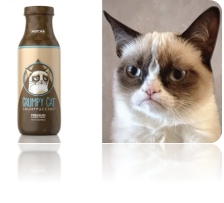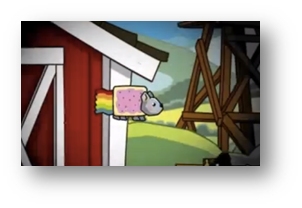- within Intellectual Property topic(s)
- with readers working within the Media & Information and Law Firm industries
- within Intellectual Property topic(s)
- with readers working within the Media & Information and Law Firm industries
- within Real Estate and Construction, Corporate/Commercial Law and Finance and Banking topic(s)
In current day's digital world, memes are an integral part of our daily communication. Unlike earlier days when people began their days with 'Good Morning' texts, most now kickstart their day by liking and sharing memes with friends and family. The popularity of memes is closely connected to the short attention span of internet users.1
At its core, meme is an image, GIF, or video, altered with text or overlays to convey humour or satire. Crafting memes requires wit and awareness of current events.2 For many young individuals, meme-making has evolved into a full-time profession. However, copyright concerns surrounding memes remain a contentious issue.
Categories of Memes and copyright implications
Memes generally fall into two broad categories,
- Original Memes: Created using self-generated images or videos, qualifying as the creator's intellectual property.
- Derivative Memes: Created using pre-existing images or videos belonging to others, raising potential copyright concerns.3
The first category is relatively uncontroversial, as the memer owns the rights to the content and creates it out of his own talent and labour. The second category however attracts trouble.4 If a meme substantially reproduces a copyrighted work without adding significant transformative elements, it may constitute copyright infringement. The key test is to see whether the modification introduces a fresh, original expression or merely replicates the original one.5
Under Section 2(c) of the Indian Copyright Act, 1957 ['ICA'] memes are protected as 'artistic work'.6 Sharing or reposting a meme without the copyright holder's permission may result in 'infringing copy' under Section 2(m)(i) of ICA.7
Fair Use Doctrine and the four-factor test
A central question is whether using copyrighted content for creating memes falls under Fair use? The Doctrine of Fair use is codified under Section 52 of the ICA.8 This doctrine serves to uphold the Freedom to express provided under Article 19(1) of the India's Constitution.9 It provides exceptions to copyright infringement, allowing the content's limited usage and maintaining its sanctity.10
Work may qualify as fair use if it is utilized for private use, research, criticism, report of ongoing events or educational purposes.11 However, fair use laws vary across jurisdictions. For instance, Australian copyright law explicitly includes satire within fair use protections.12
The High court of Delhi in the case of India TV v. Yashraj Films outlined a four-factor test to determine fair use, emphasizing that these factors must be considered holistically:13
- Purpose of use- If memes are created for commercial gains rather than amusement or satire, they are less likely to qualify as fair use.
- Nature of the copyrighted work- This distinction between published and unpublished works matters. Memes typically derive from published works, making fair use more defensible, as the original creator has already exhausted their first publication right.
- Substantiality of the portion used- Borrowing a minor phrase or joke from a larger work is less likely to constitute infringement compared to replicating an entire scene or artwork.
- Effect on the market value- If the meme competes with or diminishes the commercial value of the original work, it is unlikely to be protected under fair use.14 This factor has been affirmed by the High court of Madras in Blackwood & Sons Ltd v. A.N Parasuraman.15
Furthermore, memes that violate Right to privacy or cause societal harm are not protected under fair use. In a notable instance, BJP youth leader Priyanka Sharma was ordered by the Supreme court to apologize for sharing a morphed image of Mamata Banerjee. Court affirmed that 'Freedom of expression faces its end when it violates rights of others.'16
Commercialization of Memes and copyright concerns
Initially, memes were merely a source of amusement. However, they have now become a major tool for marketing and branding. Companies increasingly rely on memes to promote their products due to their cost effectiveness and ability to engage audiences.17 Rapper Drake for example strategically designed a music video to be easily adapted into memes, to increase its reach.18
Memers are also engaging in a "reach war" seeking to increase their followers and monetize their accounts.19 This commercial intent will significantly reduce the likelihood of memes to be protected under fair use.
In the case of Grumpy Cat Ltd. v. Grenade Beverage LLC.20 The plaintiff had trademark and copyright over Grumpy cat. She successfully sued the defendant for going beyond the contractual terms. The California federal jury awarded $701,000 in damages.21

In Cristopher Orlando v. 5th Cell Media LLC and Warner Bros Entertainment Inc,22 the plaintiff sued the defendants for the unauthorized use of Nyan Cat in their video game. Court ruled in plaintiff's favour and awarded compensation.23

Role of Intermediaries
Social media platforms and Internet Service Providers ['ISPs'] play a crucial role in the circulation of memes raising questions about their responsibility. Countries maintain different views on this issue.
In India, The Information Technology (Intermediary Guidelines and Digital Media Ethics Code) Rule 4(2) of 2021 empowers courts to order platforms like Facebook and Instagram to disclose the identity of a meme's creator if the content threatens the sovereignty or integrity of India.24 But intermediaries are usually absolved of liability of their role is limited to providing access alone.
In USA according to the Digital Millenium Copyright Act of 1988 intermediaries are required to promptly remove infringing content upon notification. They must not alter content, store infringing material, or receive monetary gains from it.25
Conclusion
Memes are meant for entertainment purposes offering humour, satire, and social commentary. But meme creators must also be vigilant about the copyright laws. Intermediaries should uphold copyrights and ensure that due diligence is followed. Users should remain mindful about their ethical obligations and back up from sharing defamatory and objectionable content in the digital spaces.
References:
Case Laws:
- Blackwood & Sons Ltd v. A.N Parasuraman AIR 1959 MAD 410.
- Charles Schmidt & Christopher Orlando Torres v. Warner Bros Entertainment CV 13-02824.
- Grumpy Cat Ltd. v. Grenade Beverage LLC, Case No. SA CV 15-2063.
- Wiley Eastern Ltd. v. Indian Institute of Management, 1995 IAD (Delhi) 1021.
Internet Articles
- Amy Adler & Jeanne Fromer, The Law of memes: Amy Adler and Jeanne Fromer argue that memes, which raise questions about conventional notions of copyright law, have considerable legal and cultural significance, NYU Law News, (Jan.19, 2022) https://www.law.nyu.edu/news/ideas/memes-copyright-law-amy-adler-jeanne fromer/ (last visited Feb 8, 2025).
- Avanthi, Meme and its Copyright- Prometheus IP, (Feb 23.2021) https://www.prometheusip.com/copyrights/meme-and-its-copyright/ (last visited Feb 10, 2025).
- Copyright provisions pertaining to 'Internet Memes' in India (May 27.2022) https://csipr.nliu.ac.in/copyright/copyright-provisions-pertaining-to-internet memes-in-india/ (last visited Feb 9, 2025).
- Divanshi Gupta, Laugh out loud, Legally: Copyright Considerations in Memes, Chadha & Chadha IP, (July 12. 2023) https://www.candcip.com/single-post/laugh-out-loud-legally-copyright considerations-in-memes/ (last visited Feb 8, 2025).
- Manvee, Protecting memes vis-à-vis Copyright: A way forward (Oct 26.2022) https://timesofindia.indiatimes.com/readersblog/oped-by-manvee/protecting memes-vis-a-vis-copyright-a- way-forward-46001/ (last visited Feb 8, 2025).
- Memes and Copyright Protection (Dec 6.2021) https://ssrana.in/articles/memes-and-copyright-protection/ (last visited Feb 9, 2025).
- Navantak Agrawal, Meme marketing and Copyright: With great power comes great responsibilities https://sandalawoffices.com/meme-marketing-and-copyright-with-great-power comes-great-responsibilities/ (last visited Feb 10, 2025).
- Shubhank Suman, Analysis of memes and copyright infringement, (Dec 5.2021) https://blog.ipleaders.in/analysis-of-memes-and-copyright-infringement/ (last visited Feb 10, 2025).
Footnotes
1. Amy Adler & Jeanne Fromer, The Law of memes, (Jan.19, 2022) https://www.law.nyu.edu/news/ideas/memes-copyright-law-amy-adler-jeanne fromer/ (last visited Feb 8, 2025).
2. Divanshi Gupta, Laugh out loud, Legally: Copyright Considerations in Memes, Chadha & Chadha IP, (July 12. 2023) https://www.candcip.com/single-post/laugh-out-loud-legally-copyright considerations-in-memes/ (last visited Feb 8, 2025).
3. Manvee, Protecting memes vis-à-vis Copyright: A way forward (Oct 26.2022) https://timesofindia.indiatimes.com/readersblog/oped-by-manvee/protecting memes-vis-a-vis-copyright-a- way-forward-46001/ (last visited Feb 8, 2025).
4. Memes and Copyright Protection (Dec 6.2021) https://ssrana.in/articles/memes-and-copyright-protection/ (last visited Feb 9, 2025).
5. Copyright provisions pertaining to 'Internet Memes' in India (May 27.2022) https://csipr.nliu.ac.in/copyright/copyright-provisions-pertaining-to-internet memes-in-india/ (last visited Feb 9, 2025).
6. The Copyright Act, 1957, § 2(c), Act no. 14 of 1957 (India) [hereinafter 'ICA'].
7. ICA, § 2(m)(i).
8. ICA, § 52.
9. Wiley Eastern Ltd. v. IIM, IAD, Delhi (1995) 1021; supra note 3.
10. Avanthi, Meme and its Copyright- Prometheus IP, (Feb 23.2021) https://www.prometheusip.com/copyrights/meme-and-its-copyright/ (last visited Feb 10, 2025).
11. ICA, § 52.
12. supra note 3.
13. Navantak Agrawal, Meme marketing and Copyright: With great power comes great responsibilities https://sandalawoffices.com/meme-marketing-and-copyright-with-great-power comes-great-responsibilities/ (last visited Feb 10, 2025).
14. supra note 3.
15. Blackwood & Sons Ltd v. A.N Parasuraman AIR 1959 MAD 410; supra note 3.
16. supra note 4.
17. supra note 10.
18. supra note 1.
19. Shubhank Suman, Analysis of memes and copyright infringement, (Dec 5.2021) https://blog.ipleaders.in/analysis-of-memes-and-copyright-infringement/ (last visited Feb 10, 2025).
20. Grumpy Cat Ltd. v. Grenade Beverage LLC, SA CV 15-2063.
21. supra note 2.
22. Charles L Schmidt v. Warner Bros Entertainment Inc, 2:13-cv-02824.
23. supra note 2.
24. supra note 3.
25. Aishwarya, Protection of memes under copyright law, Jus Corpus Law Journal, 361, 366 (2022).
The content of this article is intended to provide a general guide to the subject matter. Specialist advice should be sought about your specific circumstances.

